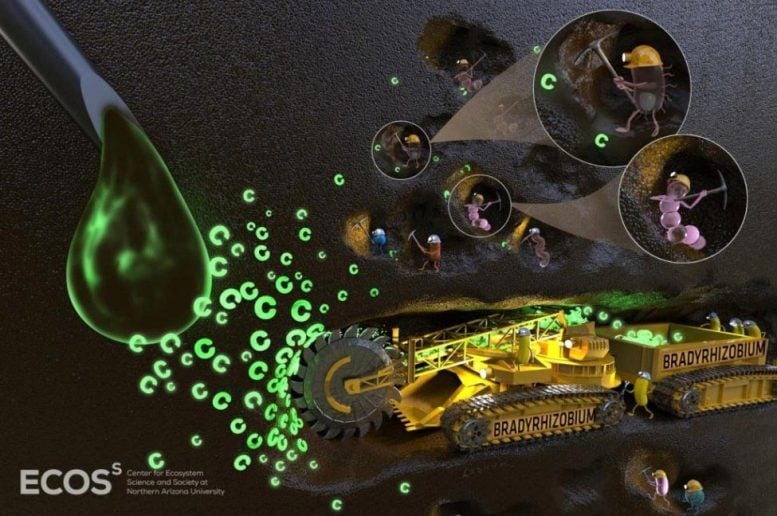
Bacterial Carbon Cycling in Soil Is Not a Shared Effort
Scientists can capture valuable demographic data about soil microbes with a tool called quantitative stable isotope probing (qSIP). This tool reveals the identity of bacteria in a community and whether they are using nutrients or are growing. In a new qSIP study, scientists found that in many soil environments just a few types of bacteria use more than half of the available carbon. Despite being home to thousands of species, only three to six groups of bacteria were responsible for most of the carbon use that occurred in several soils that were tested.
Soil contains twice as much carbon as all the vegetation on earth. To understand future climate dynamics, scientists must predict how microbial activity stores carbon in soil or releases it as carbon dioxide. By learning which bacteria in a community are responsible for important ecosystem functions, like carbon cycling, scientists can focus future research on these key bacterial groups. This research also helps to expand the broader field of microbiology.
Researchers at Northern Arizona University and Pacific Northwest National Laboratory analyzed soil samples to follow the oxygen in 18O-labeled water to see which species incorporated it into their DNA. Such uptake is a proxy for growth and can be used to model how efficiently bacteria consume soil carbon.
When the model included details on bacteria (specifically, taxonomic specificity, genome size, and growth) it more accurately predicted the measured carbon dioxide than models that looked only at the abundance of each bacterial group.
Key Bacteria Behind Carbon Cycling
Researchers observed that just a few genera produced most of the carbon dioxide released from soils. Those bacteria included Bradyrhizobium, Acidobacteria RB41, and Streptomyces. These bacteria were better than less abundant species at using existing soil carbon as well as nutrients that were added to the soil. When carbon and nitrogen were added to the soil, the dominant bacteria species consolidated their control of the nutrients, gobbling up more nutrients and growing faster relative to other taxa in the soil.
The research identified thousands of unique organisms and hundreds of distinct genera, but just six groups of bacteria accounted for more than 50 percent of carbon use. The concentration of activity was even more pronounced in the nutrient-boosted soil, where just three groups were responsible for more than half the carbon use.
This research provides insights for managing soil fertility and for better representing key bacterial processes in earth system and climate models.
Reference: “Nutrients cause consolidation of soil carbon flux to small proportion of bacterial community” by Bram W. Stone, Junhui Li, Benjamin J. Koch, Steven J. Blazewicz, Paul Dijkstra, Michaela Hayer, Kirsten S. Hofmockel, Xiao-Jun Allen Liu, Rebecca L. Mau, Ember M. Morrissey, Jennifer Pett-Ridge, Egbert Schwartz and Bruce A. Hungate, 7 June 2021, Nature Communications.
DOI: 10.1038/s41467-021-23676-x
This work was supported by the Department of Energy Office of Science, Office of Biological and Environmental Research.
Never miss a breakthrough: Join the SciTechDaily newsletter.